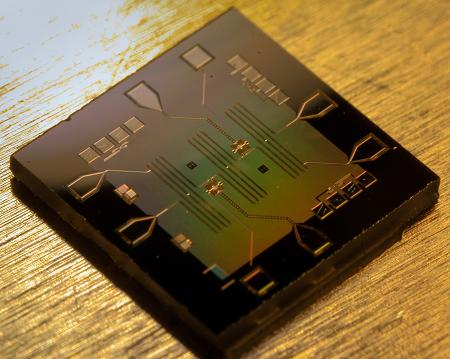Home > Press > International Team of Scientists Says It's High 'Noon' for Microwave Photons
 |
| Image of chip containing the superconducting integrated circuit used to generate NOON microwave states. Credit: Erik Lucero, UCSB |
Abstract:
An important milestone toward the realization of a large-scale quantum computer, and further demonstration of a new level of the quantum control of light, were accomplished by a team of scientists at UC Santa Barbara and in China and Japan.
International Team of Scientists Says It's High 'Noon' for Microwave Photons
Santa Barbara, CA | Posted on February 16th, 2011The study, published in the Feb. 7 issue of the journal Physical Review Letters, involved scientists from Zhejiang University, China, and NEC Corporation, Japan. The experimental effort was pursued in the research groups of UCSB physics professors Andrew Cleland and John Martinis.
The team described how they used a superconducting quantum integrated circuit to generate unique quantum states of light known as "NOON" states. These states, generated from microwave frequency photons, the quantum unit of light, were created and stored in two physically-separated microwave storage cavities, explained first author Haohua Wang, postdoctoral fellow in physics at UCSB. The quantum NOON states were created using one, two, or three photons, with all the photons in one cavity, leaving the other cavity empty. This was simultaneous with the first cavity being empty, with all the photons stored in the second cavity.
"This seemingly impossible situation, allowed by quantum mechanics, led to interesting results when we looked inside the cavities," said second author Matteo Mariantoni, postdoctoral fellow in physics at UCSB. "There was a 50 percent chance of seeing all the photons in one cavity, and a 50 percent chance of not finding any -- in which case all the photons could always be found in the other cavity."
However, if one of the cavities was gently probed before looking inside, thus changing the quantum state, the effect of the probing could be seen, even if that cavity was subsequently found to be empty, he added.
"It's kind of like the states are ghostly twins or triplets," said Wang. "They are always together, but somehow you never know where they are. They also have a mysterious way of communicating, so they always seem to know what is going to happen." Indeed, these types of states display what Einstein famously termed, "spooky action at a distance," where prodding or measuring a quantum state in one location affects its behavior elsewhere.
The quantum integrated circuit, which includes superconducting quantum bits in addition to the microwave storage cavities, forms part of what eventually may become a quantum computational architecture.
####
For more information, please click here
Contacts:
Gail Gallessich
805-893-7220
George Foulsham
805-893-3071
Copyright © UC Santa Barbara
If you have a comment, please Contact us.Issuers of news releases, not 7th Wave, Inc. or Nanotechnology Now, are solely responsible for the accuracy of the content.
| Related News Press |
News and information
![]() Researchers develop molecular qubits that communicate at telecom frequencies October 3rd, 2025
Researchers develop molecular qubits that communicate at telecom frequencies October 3rd, 2025
![]() Next-generation quantum communication October 3rd, 2025
Next-generation quantum communication October 3rd, 2025
![]() "Nanoreactor" cage uses visible light for catalytic and ultra-selective cross-cycloadditions October 3rd, 2025
"Nanoreactor" cage uses visible light for catalytic and ultra-selective cross-cycloadditions October 3rd, 2025
Academic/Education
![]() Rice University launches Rice Synthetic Biology Institute to improve lives January 12th, 2024
Rice University launches Rice Synthetic Biology Institute to improve lives January 12th, 2024
![]() Multi-institution, $4.6 million NSF grant to fund nanotechnology training September 9th, 2022
Multi-institution, $4.6 million NSF grant to fund nanotechnology training September 9th, 2022
Quantum Computing
![]() Researchers develop molecular qubits that communicate at telecom frequencies October 3rd, 2025
Researchers develop molecular qubits that communicate at telecom frequencies October 3rd, 2025
![]() Researchers tackle the memory bottleneck stalling quantum computing October 3rd, 2025
Researchers tackle the memory bottleneck stalling quantum computing October 3rd, 2025
![]() Japan launches fully domestically produced quantum computer: Expo visitors to experience quantum computing firsthand August 8th, 2025
Japan launches fully domestically produced quantum computer: Expo visitors to experience quantum computing firsthand August 8th, 2025
Announcements
![]() Rice membrane extracts lithium from brines with greater speed, less waste October 3rd, 2025
Rice membrane extracts lithium from brines with greater speed, less waste October 3rd, 2025
![]() Researchers develop molecular qubits that communicate at telecom frequencies October 3rd, 2025
Researchers develop molecular qubits that communicate at telecom frequencies October 3rd, 2025
![]() Next-generation quantum communication October 3rd, 2025
Next-generation quantum communication October 3rd, 2025
![]() "Nanoreactor" cage uses visible light for catalytic and ultra-selective cross-cycloadditions October 3rd, 2025
"Nanoreactor" cage uses visible light for catalytic and ultra-selective cross-cycloadditions October 3rd, 2025
Research partnerships
![]() Lab to industry: InSe wafer-scale breakthrough for future electronics August 8th, 2025
Lab to industry: InSe wafer-scale breakthrough for future electronics August 8th, 2025
![]() HKU physicists uncover hidden order in the quantum world through deconfined quantum critical points April 25th, 2025
HKU physicists uncover hidden order in the quantum world through deconfined quantum critical points April 25th, 2025
|
|
||
|
|
||
| The latest news from around the world, FREE | ||
|
|
||
|
|
||
| Premium Products | ||
|
|
||
|
Only the news you want to read!
Learn More |
||
|
|
||
|
Full-service, expert consulting
Learn More |
||
|
|
||








